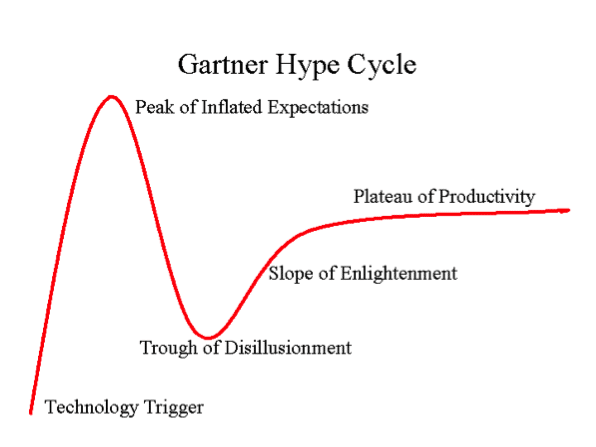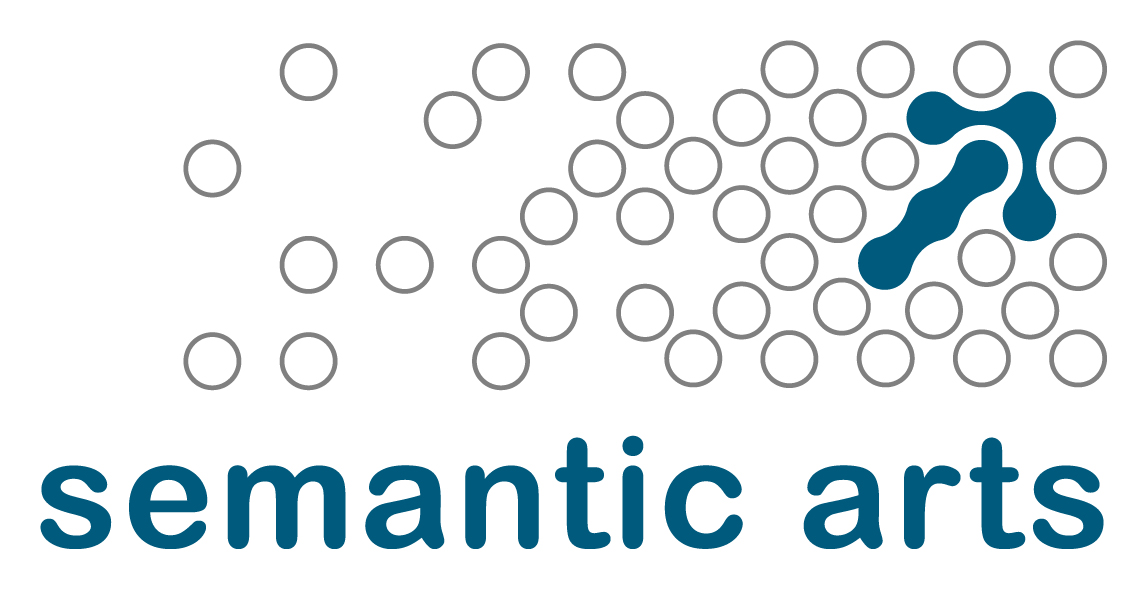Gartner has, finally, nominated Semantic Technology as one of their Top Technology Trends. We’ve seen this movie before. We know how it ends. Indeed it was Gartner themselves who named the plot trajectory: the “hype cycle.” It’s worth a pause to reflect on why the hype cycle exists. The hype cycle suggests that a new technology follows a development growth path as predictable as egg to caterpillar to chrysalis to butterfly. In the hype cycle, the stages are: Let’s think about the underlying dynamics. At first there is a product or approach that purports to solve an existing problem. If it doesn’t, it falls off the radar. If it does, the implementer and often the implementee get bragging rights at conferences and magazines. They tout the benefits (let’s say, increased inventory turns) and some aspect of the approach that led to the benefit (let’s say, genetic algorithms). A few other firms pick up on the relative advantage being gained by the early adopter, and many actually get the connection between the approach or the technology (genetic algorithms) and the result (increased inventory turns). Up to this point there is no hype cycle, just good old-fashioned diffusion of innovation which has been widely studied since the introduction of hybrid corn in the 1930’s. In order to fuel a hype cycle you need someone hyping. Certainly some vendors will hype their solutions. But most customers are immune to this puffery, and can afford to sit on the sidelines. But when someone with the ability to move markets like Gartner weighs in, the industry is obligated to take notice. Customers, wary of missing out on the next big thing, wade in. But it is at this juncture that the connection between the feature (genetic algorithms in this example) and the benefit (increased inventory turns) gets severed. Vendors rush in to supply the new technology, and everyone is in too much of a hurry to worry about the benefits. The trough of disillusionment shows up, just as the bow wave of these projects crests. The projects complete (without benefit) or get cancelled. Disappointment is rampant. The dead are buried, companies move on. But a few projects persist. A few actually get the promised benefits. After a couple more implementation cycles, the patterns finally emerge about how to do this well. The technology is redeemed, and we are declared to be on the “slope of enlightenment.” We were helping clients with SOA design in the early days, and there was a time when the techniques and the benefits were actually connected. We found it amusing years later to see that Gartner had observed that SOA implementation was going through four phases to get to maturity. In our opinion, the fourth phase was really where companies should have started, were it not for the help they got from over-eager vendors on the bandwagon. The same was true with MDM and at least a dozen other hot technologies. That is the general pattern. How do we think it will play out in Semantic Technology? Who will gain and lose in the Semantic Technology hype cycle? Vendors of Semantic Technology products of course will be the immediate beneficiaries, as will any technology that can get the “Semantics Inside” stickers on their products in time for their next marketing campaign. As we saw with MDM, once the market shifted from professional services firms solving real problems to software vendors selling products, it was the beginning of the end. That’s not to say that the products are bad or unnecessary; it’s just that in thrall of the hype cycle customers tend to purchase first and plan later. The other constituents to benefit are the large professional services firms. We can reliably predict that firms with a bench will suddenly discover that they had semantic skills in-house (“how hard could this be?”). Anyone who can spell “ontologies” will soon become an expert. (I just noticed that even this has become easier: as of Word 2013 Microsoft finally included “ontologies” in their standard spelling dictionary, however, it looks like “ontologist” will have to wait for the next version.) So, who is harmed in this stage of the hype cycle? Most customers. Those who buy a product and then look for an application or those that believe what the newly minted semantic experts tell them. Also harmed are the firms who know what they are doing and have been delivering value all along. Recruiting, always difficult, will become more so as the gold rush plays out. And there will be pricing pressure as the wave of new ontologists puts commodity pricing pressure on the industry. I wasn’t looking forward to this day, but here we are. Let’s try to make the most of it and see how many companies we can get to the “plateau of productivity” while everyone else is slogging it out in the trough.
Let’s think about the underlying dynamics. At first there is a product or approach that purports to solve an existing problem. If it doesn’t, it falls off the radar. If it does, the implementer and often the implementee get bragging rights at conferences and magazines. They tout the benefits (let’s say, increased inventory turns) and some aspect of the approach that led to the benefit (let’s say, genetic algorithms). A few other firms pick up on the relative advantage being gained by the early adopter, and many actually get the connection between the approach or the technology (genetic algorithms) and the result (increased inventory turns). Up to this point there is no hype cycle, just good old-fashioned diffusion of innovation which has been widely studied since the introduction of hybrid corn in the 1930’s. In order to fuel a hype cycle you need someone hyping. Certainly some vendors will hype their solutions. But most customers are immune to this puffery, and can afford to sit on the sidelines. But when someone with the ability to move markets like Gartner weighs in, the industry is obligated to take notice. Customers, wary of missing out on the next big thing, wade in. But it is at this juncture that the connection between the feature (genetic algorithms in this example) and the benefit (increased inventory turns) gets severed. Vendors rush in to supply the new technology, and everyone is in too much of a hurry to worry about the benefits. The trough of disillusionment shows up, just as the bow wave of these projects crests. The projects complete (without benefit) or get cancelled. Disappointment is rampant. The dead are buried, companies move on. But a few projects persist. A few actually get the promised benefits. After a couple more implementation cycles, the patterns finally emerge about how to do this well. The technology is redeemed, and we are declared to be on the “slope of enlightenment.” We were helping clients with SOA design in the early days, and there was a time when the techniques and the benefits were actually connected. We found it amusing years later to see that Gartner had observed that SOA implementation was going through four phases to get to maturity. In our opinion, the fourth phase was really where companies should have started, were it not for the help they got from over-eager vendors on the bandwagon. The same was true with MDM and at least a dozen other hot technologies. That is the general pattern. How do we think it will play out in Semantic Technology? Who will gain and lose in the Semantic Technology hype cycle? Vendors of Semantic Technology products of course will be the immediate beneficiaries, as will any technology that can get the “Semantics Inside” stickers on their products in time for their next marketing campaign. As we saw with MDM, once the market shifted from professional services firms solving real problems to software vendors selling products, it was the beginning of the end. That’s not to say that the products are bad or unnecessary; it’s just that in thrall of the hype cycle customers tend to purchase first and plan later. The other constituents to benefit are the large professional services firms. We can reliably predict that firms with a bench will suddenly discover that they had semantic skills in-house (“how hard could this be?”). Anyone who can spell “ontologies” will soon become an expert. (I just noticed that even this has become easier: as of Word 2013 Microsoft finally included “ontologies” in their standard spelling dictionary, however, it looks like “ontologist” will have to wait for the next version.) So, who is harmed in this stage of the hype cycle? Most customers. Those who buy a product and then look for an application or those that believe what the newly minted semantic experts tell them. Also harmed are the firms who know what they are doing and have been delivering value all along. Recruiting, always difficult, will become more so as the gold rush plays out. And there will be pricing pressure as the wave of new ontologists puts commodity pricing pressure on the industry. I wasn’t looking forward to this day, but here we are. Let’s try to make the most of it and see how many companies we can get to the “plateau of productivity” while everyone else is slogging it out in the trough.

